AWS Certified Developer - Associate
Security
KMS Basics Demo
In this article, we demonstrate how to effectively work with AWS Key Management Service (KMS). You'll learn about the different types of keys available, how to create and manage a customer-managed key, and how to securely encrypt and decrypt data using the AWS CLI.
Exploring the KMS Console
Begin by searching for the KMS service in the AWS Console. Once selected, you'll be directed to the KMS page, which displays several tabs on the left, including:
- AWS Managed Keys
- Customer Managed Keys
AWS Managed Keys
If you haven't created any keys yet, the Customer Managed Keys section may be empty. In contrast, the AWS Managed Keys tab displays automatically created keys. For instance, when you use services like Amazon S3 that offer built-in or default encryption, AWS will create and manage keys on your behalf.
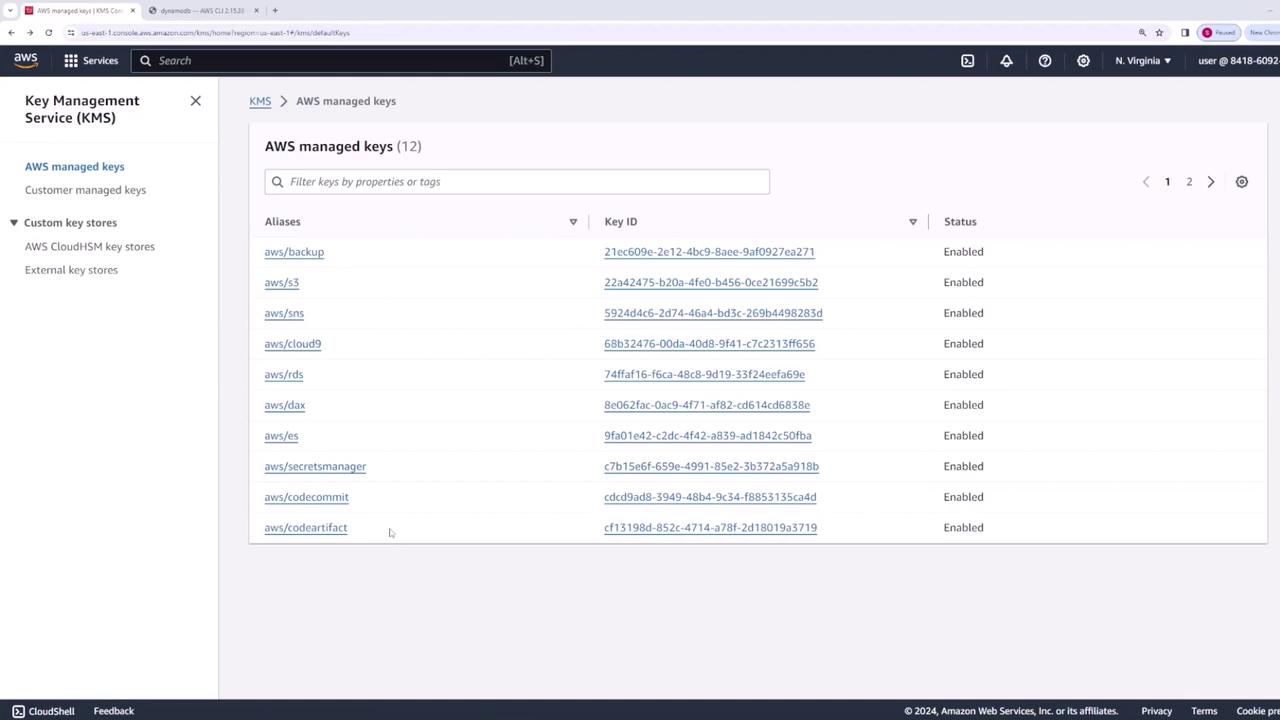
AWS S3 uses these AWS Managed Keys to encrypt files stored in buckets by default. The key policy determines which entities can perform cryptographic actions (e.g., encrypt, decrypt, re-encrypt, generate data keys, and describe the key). For example, a typical AWS managed key policy may look like this:
{
"Action": [
"kms:Encrypt",
"kms:Decrypt",
"kms:ReEncrypt*",
"kms:GenerateDataKey*",
"kms:DescribeKey"
],
"Resource": "*",
"Condition": {
"StringEquals": {
"kms:ViaService": "s3.us-east-1.amazonaws.com",
"kms:CallerAccount": "841860927337"
}
}
}
This policy snippet specifies that the S3 service from the given account is permitted to perform these actions.
Another example policy allows access through S3 for all principals in the account:
{
"Sid": "Allow access through S3 for all principals in the account that are authorized to use S3",
"Effect": "Allow",
"Principal": {
"AWS": "*"
},
"Action": [
"kms:Encrypt",
"kms:Decrypt",
"kms:ReEncrypt",
"kms:GenerateDataKey",
"kms:DescribeKey"
],
"Resource": "*"
}
Additionally, AWS KMS uses symmetric keys, which allow both encryption and decryption of data.
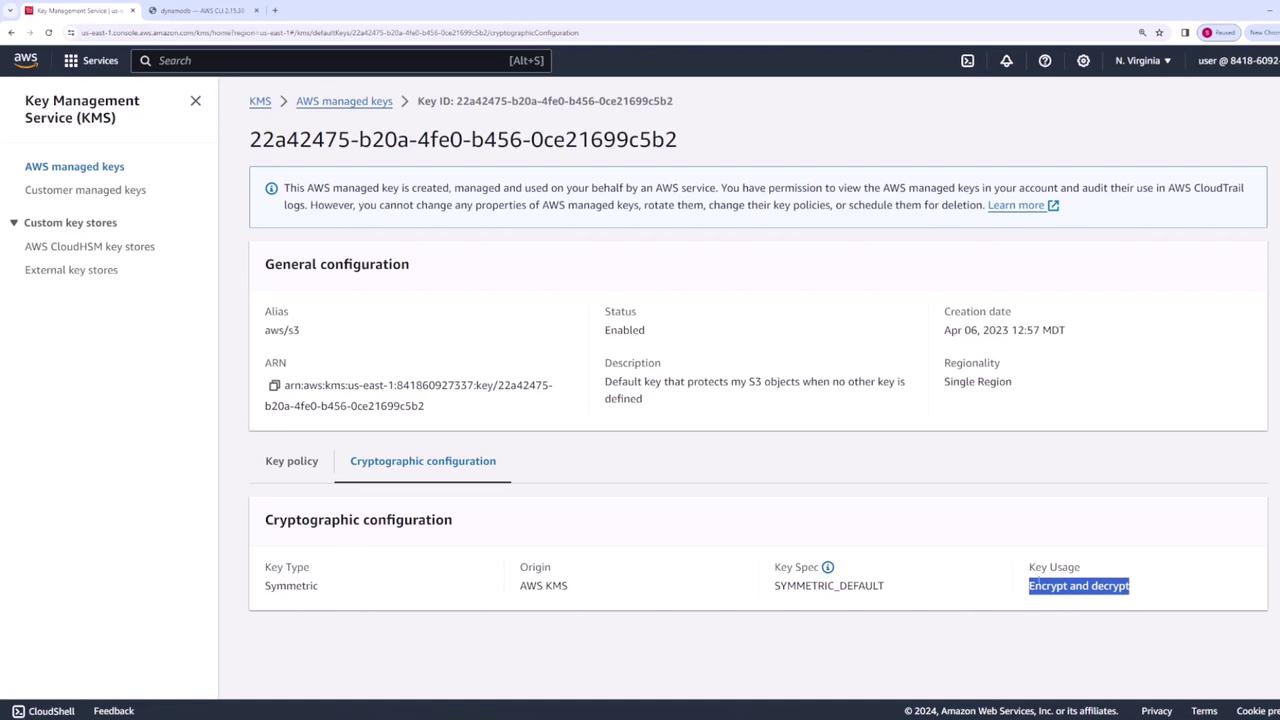
Creating a Customer Managed Key
Now, we'll create a customer-managed key that gives you full control over key management.
- Start Key Creation:
- Click on "Create key" and select whether you want a symmetric or asymmetric key. For this demonstration, choose a symmetric key that supports both encryption and decryption.
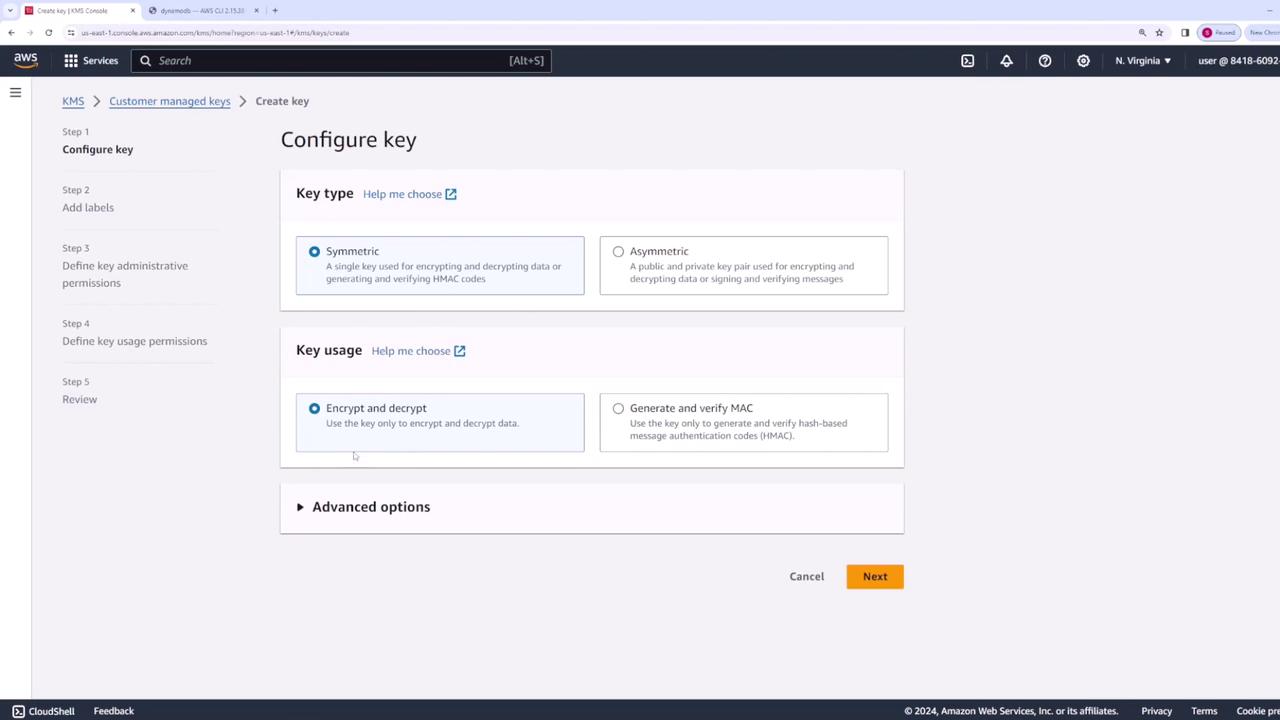
- Key Material Origin:
- Select the source of key material. Options include AWS KMS-managed key material, imported key material, using an external key store, or CloudHSM. In this demo, allow AWS KMS to manage the key material.

Regionality:
- Choose whether to create a single-region key or a multi-region key. For this demonstration, select a single-region key.
Naming the Key:
- Provide a name for your key (e.g., "demo") and click "Next."
Defining Key Administrators:
- Administrators can manage key configurations and delete the key. By default, your user account is set as an administrator, but you may add others if needed.
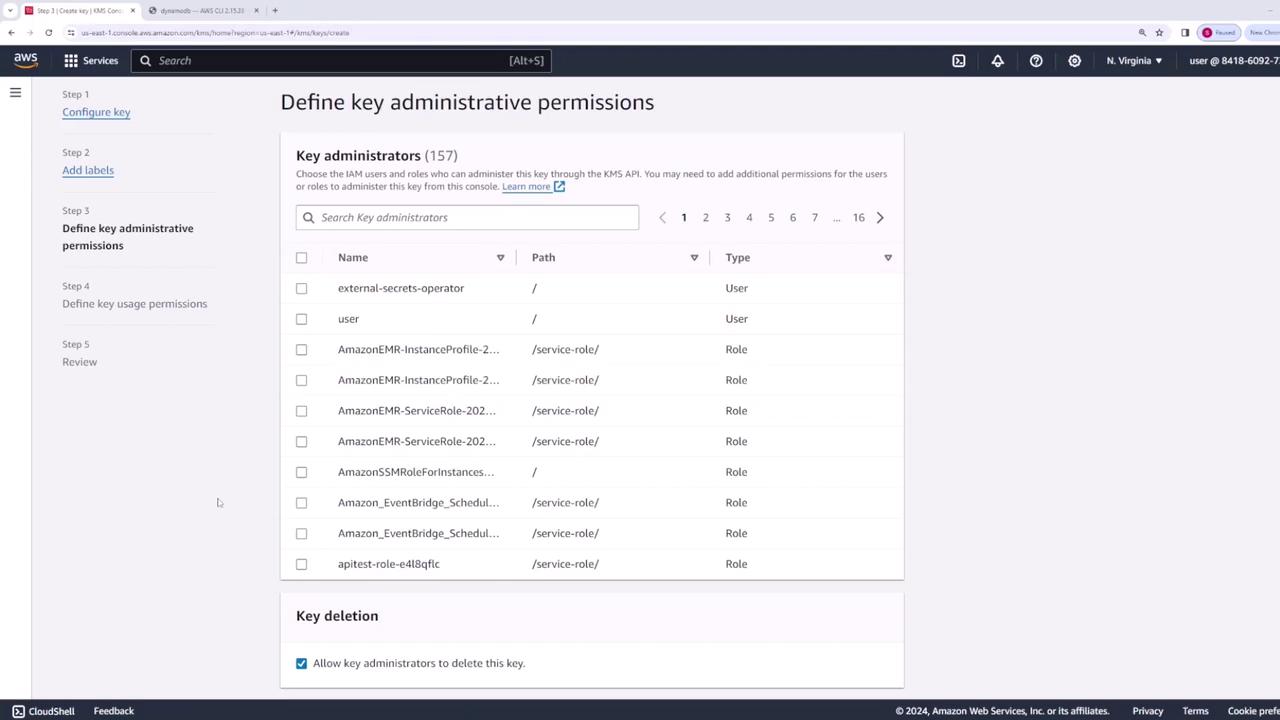
- Defining Key Usage Permissions:
- Key users are granted permissions for cryptographic operations like encryption and decryption, while administrators manage key settings. Though IAM users with KMS access can use the key by default, you can restrict these permissions to specific users.

After reviewing the key policy, you might see a policy similar to the following:
{
"Id": "key-consolepolicy-3",
"Version": "2012-10-17",
"Statement": [
{
"Sid": "Enable IAM User Permissions",
"Effect": "Allow",
"Principal": {
"AWS": "arn:aws:iam::841860927337:root"
},
"Action": "kms:*",
"Resource": "*"
}
]
}
This policy grants full permissions to the root user on KMS. If you add additional key administrators (for example, a user named "user"), the policy will include extra statements for those specific administrative actions:
{
"Sid": "Allow access for Key Administrators",
"Effect": "Allow",
"Principal": {
"AWS": "arn:aws:iam::841869092733:user/user"
},
"Action": [
"kms:Create",
"kms:Describe",
"kms:Enable",
"kms:List",
"kms:Put",
"kms:Update",
"kms:Disable",
"kms:Revoke",
"kms:Get",
"kms:Delete",
"kms:TagResource",
"kms:UntagResource",
"kms:ScheduleKeyDeletion",
"kms:CancelKeyDeletion",
"kms:RotateKeyOnDemand"
]
}
Similarly, a key user (e.g., an "external secrets operator" or a dedicated role) might have restricted permissions for regular cryptographic operations:
{
"Version": "2012-10-17",
"Statement": [
{
"Sid": "Allow use of the key",
"Effect": "Allow",
"Principal": {
"AWS": [
"arn:aws:iam::841868927373:user/external-secrets-operator",
"arn:aws:iam::841868927373:role/service-role-e418qflc"
]
},
"Action": [
"kms:Encrypt",
"kms:Decrypt",
"kms:ReEncrypt*",
"kms:GenerateDataKey*",
"kms:DescribeKey"
],
"Resource": "*"
}
]
}
Note
You can always adjust these permissions later in the key policy view based on your security requirements.
Complete the key creation process. Once created, the key's details will appear under Customer Managed Keys. The key policy displays administrator and user permissions, and the cryptographic configuration confirms that the key is symmetric. The key’s alias (such as "demo"), ARN, and status (enabled) are also visible. You also have the option to disable the key or schedule it for deletion if needed.
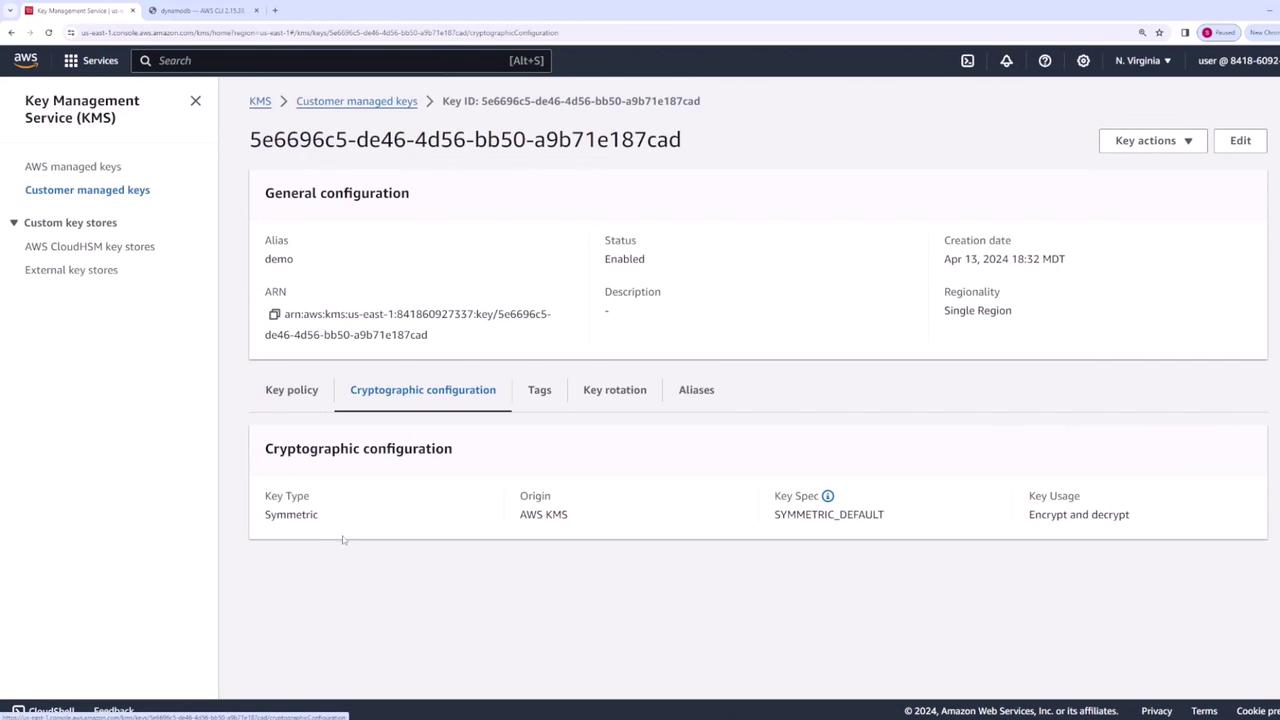
Key Rotation
AWS KMS supports automatic key rotation. To activate key rotation, click the "Edit" button in the key rotation settings, enable automatic rotation, and set the desired rotation period (in days).
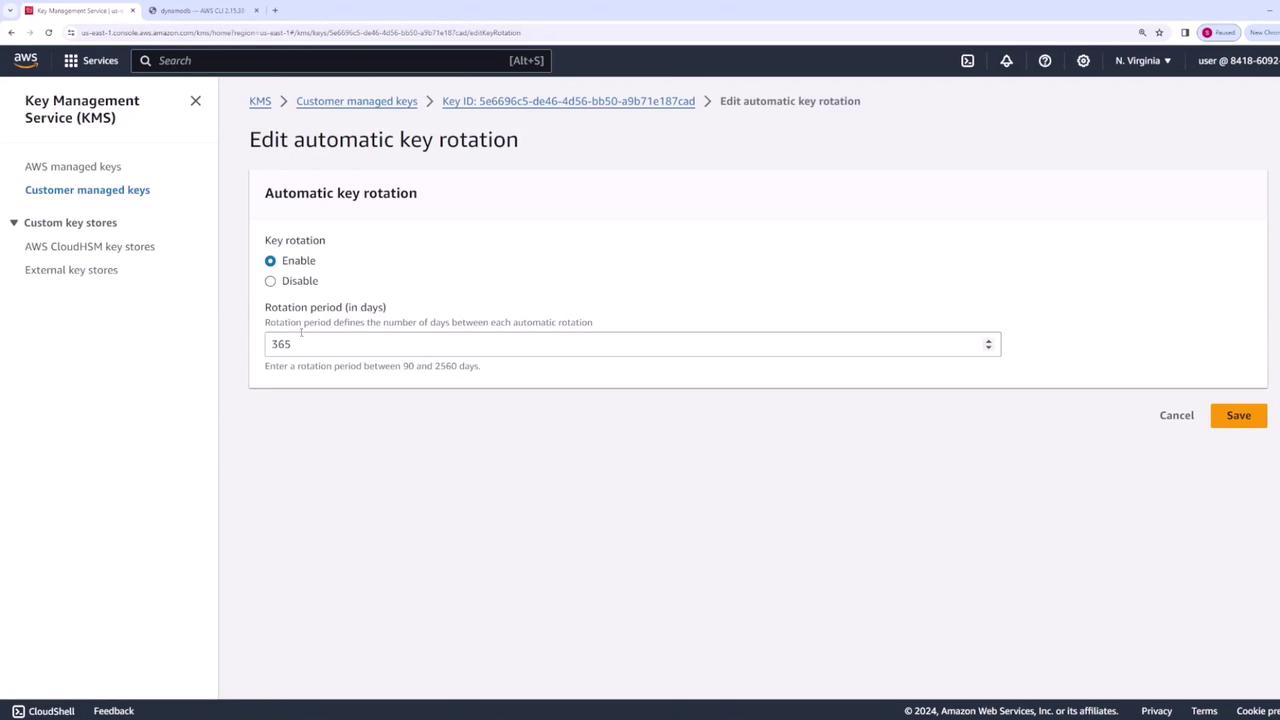
Encrypting and Decrypting Data Using AWS CLI
Now that your customer-managed key is set up, you can use it to encrypt and decrypt data via the AWS CLI. Assume you have a file named "db-credentials" containing your database credentials:
db-password: mypassword123
Encrypting Data
To encrypt the contents of the "db-credentials" file, run the following command:
aws kms encrypt --key-id alias/demo --plaintext fileb://db-credentials --output text --query CiphertextBlob > encrypted-db-credentials
This command uses the key identified by the alias "demo", reads the "db-credentials" file (ensuring binary input with "fileb://"), and outputs a base64 encoded ciphertext blob into "encrypted-db-credentials".
Since the ciphertext is base64 encoded, convert it to pure binary form with this command:
cat encrypted-db-credentials | base64 -di > encrypted-db-credentials-decoded
You may alternatively specify the key ID instead of the alias if needed.
Decrypting Data
To decrypt the encrypted data, run:
aws kms decrypt --ciphertext-blob fileb://encrypted-db-credentials-decoded --output text --query Plaintext > decrypted-file
The decrypted output remains base64 encoded. Decode it to restore the original plaintext:
cat decrypted-file | base64 -d > decrypted-and-decoded-file
After executing these steps, the file "decrypted-and-decoded-file" will contain the original credentials:
db-password: mypassword123
Note
When using symmetric keys in AWS KMS, the service automatically detects the proper key during decryption. Hence, specifying the key ID during decryption is not required if it's already linked with the ciphertext.
Summary of Commands
The following commands summarize the process used in this demonstration:
# Encrypt the data
aws kms encrypt --key-id alias/demo --plaintext fileb://db-credentials --output text --query CiphertextBlob > encrypted-db-credentials
# Decode the encrypted file to obtain pure binary data
cat encrypted-db-credentials | base64 -di > encrypted-db-credentials-decoded
# Decrypt the binary data
aws kms decrypt --ciphertext-blob fileb://encrypted-db-credentials-decoded --output text --query Plaintext > decrypted-file
# Decode the decrypted data to retrieve the original text
cat decrypted-file | base64 -d > decrypted-and-decoded-file
Conclusion
In this guide, we've explored how to view AWS managed keys, create a customer-managed key, and utilize the AWS CLI to encrypt and decrypt data. This process ensures that you can securely manage and use cryptographic keys with AWS KMS while maintaining granular control over key administration and usage permissions.
Watch Video
Watch video content